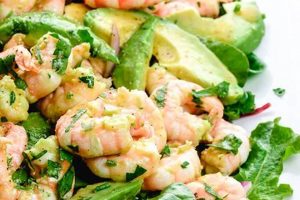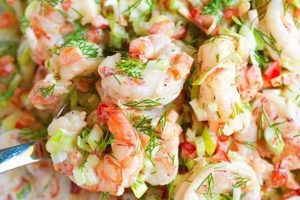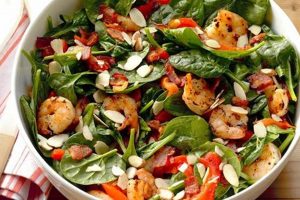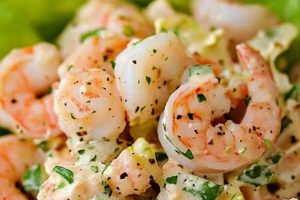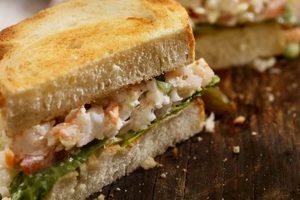A chilled seafood salad featuring cooked shrimp as the primary ingredient, this dish typically incorporates mayonnaise-based dressing and often includes celery, onion, and seasonings. The addition of Old Bay Seasoning provides a distinctive blend of herbs and spices, including celery salt, paprika, and black pepper, contributing a savory and slightly spicy flavor profile reminiscent of Chesapeake Bay cuisine.
This specific combination of ingredients offers a refreshing and flavorful meal, suitable for various occasions from casual lunches to more formal gatherings. The seasoning blend’s distinct character elevates the simple salad beyond traditional preparations. Its popularity stems from the ease of preparation and the balanced taste profile that appeals to a broad palate. Furthermore, its historical connection to the Chesapeake Bay region adds a cultural dimension to the culinary experience.
This article will explore variations on the basic recipe, offering guidance on ingredient selection, preparation techniques, and presentation suggestions to achieve optimal results. Discussions will also cover potential substitutions for dietary restrictions and complementary pairings for a complete dining experience.
Tips for an Exceptional Shrimp Salad with Old Bay Seasoning
Achieving a well-balanced and flavorful shrimp salad hinges on careful attention to ingredient quality and preparation techniques. The following tips offer guidance for elevating this classic dish.
Tip 1: Shrimp Selection and Preparation: Opt for high-quality, fresh or properly frozen shrimp. Overcooked shrimp results in a rubbery texture; therefore, brief cooking in simmering water until pink and opaque is recommended. Immediate chilling in ice water halts the cooking process and maintains a desirable texture.
Tip 2: Mayonnaise Quality and Customization: The mayonnaise serves as the foundation of the dressing. A good quality mayonnaise enhances the overall flavor profile. While classic mayonnaise provides a neutral base, flavored varieties, such as lemon or dill, can introduce complementary notes.
Tip 3: Balancing the Old Bay Seasoning: Start with a moderate amount of Old Bay and adjust to taste. The seasoning’s intensity can vary depending on the brand and individual preferences. Gradual incorporation prevents overpowering the other flavors.
Tip 4: Freshness of Produce: Crisp celery and finely diced red onion provide textural contrast and contribute to the overall flavor. Ensure these ingredients are fresh and properly chilled for optimal results.
Tip 5: Enhancements and Variations: Consider adding chopped fresh herbs, such as dill or parsley, for added brightness. A squeeze of lemon juice can also provide a balancing acidity.
Tip 6: Chilling Time: Allowing the salad to chill for at least 30 minutes allows the flavors to meld and enhances the overall experience. Extended chilling, however, can diminish the brightness of the fresh ingredients.
Tip 7: Serving Suggestions: This salad can be served on bread, crackers, lettuce cups, or as a standalone dish. Consider garnishing with a sprinkle of paprika or chopped fresh herbs for an elegant presentation.
By following these tips, one can create a shrimp salad that showcases the distinct flavor profile of Old Bay Seasoning while maintaining a balance of textures and tastes.
The following section will provide a sample recipe incorporating these recommendations for a delicious and satisfying culinary experience.
1. High-Quality Shrimp
High-quality shrimp plays a crucial role in a successful shrimp salad featuring Old Bay Seasoning. The shrimp’s inherent sweetness and delicate texture significantly influence the final dish. Tender, succulent shrimp contribute to a pleasant mouthfeel, contrasting with the crisp vegetables and creamy dressing. Conversely, lower-quality shrimp, often characterized by a mushy or rubbery texture, can detract from the overall experience. Shrimp exhibiting signs of freezer burn or an unpleasant odor will impart off-flavors, negatively impacting the delicate balance of the salad. The quality of the shrimp directly impacts the perceived freshness and overall enjoyment of the dish.
Consider the difference between freshly caught, properly handled shrimp and pre-frozen, imported shrimp. Fresh shrimp, quickly cooked and chilled, retain a natural sweetness and firm texture, enhancing the salad’s flavor profile. Pre-frozen shrimp, depending on handling and storage, may exhibit a diminished flavor and less desirable texture. For instance, improperly thawed or overcooked shrimp can become tough and rubbery, detracting from the salad’s overall appeal. Choosing larger shrimp allows for better visual presentation and a more satisfying bite, whereas smaller shrimp might become lost amongst the other ingredients. The size and quality of the shrimp influence not only the taste but also the aesthetic appeal of the finished salad.
Selecting high-quality shrimp represents an investment in the final product. While cost considerations may influence purchasing decisions, opting for superior shrimp elevates the salad from ordinary to exceptional. This distinction becomes particularly noticeable when Old Bay Seasoning is incorporated. The seasoning’s robust flavor profile requires a complementary ingredient of equal caliber. Failure to prioritize shrimp quality compromises the potential of the Old Bay seasoning and diminishes the overall sensory experience. Prioritizing high-quality shrimp, therefore, ensures that the Old Bay Seasoning complements, rather than masks, the inherent flavors of the seafood, resulting in a well-balanced and enjoyable dish.
2. Proper Shrimp Cooking
Proper shrimp cooking is paramount in a successful shrimp salad featuring Old Bay Seasoning. Overcooked shrimp develops a rubbery texture, detracting from the salad’s overall appeal. Conversely, undercooked shrimp presents food safety risks. Achieving perfectly cooked shrimp involves a delicate balance of time and temperature. The goal is to reach an internal temperature that eliminates potential hazards while preserving the shrimp’s delicate texture. Employing precise cooking methods ensures the shrimp contributes a pleasant, succulent texture to the salad, enhancing the interplay of flavors with the Old Bay Seasoning and other ingredients.
Several methods achieve optimal shrimp cooking results. Boiling briefly in seasoned water allows for even cooking and infusion of flavor. Sauting in a skillet with butter or oil provides a richer flavor profile. Steaming offers a gentle approach, preserving the shrimp’s natural sweetness. Regardless of the chosen method, the critical factor lies in avoiding overcooking. Visual cues, such as a change in color from translucent to opaque and a slight curl in shape, indicate doneness. Immediately chilling the cooked shrimp in ice water arrests the cooking process and helps maintain the desired texture. For example, a shrimp boiled for an excessive period will become tough, while a quickly sauted and chilled shrimp retains its tenderness, enhancing the final salad’s textural complexity.
The significance of proper shrimp cooking extends beyond texture. It ensures food safety, eliminating potential bacteria and preserving the shrimp’s fresh flavor. Properly cooked shrimp allows the Old Bay Seasoning to complement, rather than mask, the natural sweetness of the seafood. This harmonious blend of flavors contributes to a more satisfying culinary experience. Neglecting proper cooking techniques can lead to an unpleasant dining experience, compromising the quality of the entire salad. Therefore, mastering the art of properly cooking shrimp is essential for anyone seeking to create a truly exceptional shrimp salad featuring Old Bay Seasoning.
3. Balanced Old Bay Seasoning
Balanced Old Bay seasoning is crucial to a successful shrimp salad. Old Bay, a blend of celery salt, paprika, black pepper, and other spices, offers a distinctive flavor profile. However, its potency requires careful balancing within the overall recipe. Overuse can overwhelm the delicate flavor of the shrimp and other ingredients, resulting in a dish that tastes primarily of salt and spice. Conversely, insufficient seasoning fails to impart the characteristic Chesapeake Bay flavor that Old Bay is known for. The objective is to enhance, not dominate, the other components of the salad. Achieving this balance requires consideration of the other ingredients’ flavors and adjusting the amount of Old Bay accordingly. For example, a shrimp salad with a significant amount of lemon juice or other acidic elements might require slightly more Old Bay to compensate for the tartness. A salad with milder ingredients, such as celery and mayonnaise, necessitates a more restrained approach to Old Bay seasoning.
The practical significance of balanced Old Bay seasoning lies in its ability to elevate the shrimp salad’s overall flavor profile. When properly balanced, Old Bay contributes a savory depth and subtle heat that complements the shrimp’s sweetness and the other ingredients’ textures. This balanced approach creates a complex and nuanced flavor experience that distinguishes a great shrimp salad from a mediocre one. Consider the difference between a shrimp salad where Old Bay is the dominant flavor, masking the nuances of the shrimp and vegetables, versus one where the Old Bay harmoniously blends with the other ingredients, creating a multi-layered taste experience. This nuanced balance ultimately dictates the overall success of the dish. Over-seasoning can render the salad unpalatable, while under-seasoning results in a bland and uninspired dish.
Mastering the use of Old Bay seasoning in shrimp salad requires an understanding of its distinct flavor profile and the ability to adjust its quantity based on other ingredients. This careful calibration ensures that the Old Bay enhances rather than overwhelms the delicate balance of flavors within the salad. The ultimate goal is to create a harmonious blend of flavors and textures, resulting in a shrimp salad that is both flavorful and refreshing. This careful balance is a key differentiator between a well-executed shrimp salad and one that falls short of its full potential.
4. Fresh, Crisp Vegetables
Fresh, crisp vegetables play a vital role in a well-executed shrimp salad featuring Old Bay Seasoning. They provide essential textural contrast to the tender shrimp and creamy dressing, contributing a refreshing element that balances the richness of the other components. Beyond texture, these vegetables introduce subtle flavors and aromatic notes that enhance the overall complexity of the dish. Their judicious selection and preparation significantly impact the final product’s quality and enjoyment.
- Textural Contrast and Balance
The crispness of vegetables such as celery and red onion offers a counterpoint to the soft textures of shrimp and mayonnaise. This contrast prevents the salad from becoming monotonous, creating a more dynamic and enjoyable mouthfeel. The snap of a celery stalk or the subtle crunch of a diced red onion adds another dimension to each bite, preventing the salad from feeling heavy or overly rich. This textural interplay is essential for a balanced and satisfying culinary experience.
- Flavor Enhancement and Complexity
Beyond texture, fresh vegetables contribute subtle yet essential flavors that complement the Old Bay seasoning. Celery’s slightly bitter and herbaceous notes provide a refreshing counterpoint to the seasoning’s savory warmth. Red onion imparts a mild pungency that cuts through the richness of the mayonnaise, adding a layer of complexity. These subtle flavor interactions create a more nuanced and balanced taste profile, preventing the Old Bay from overpowering the other ingredients. The interplay of these flavors elevates the salad from simple to sophisticated.
- Visual Appeal and Freshness
Brightly colored vegetables, such as finely diced red onion, bell peppers, or chopped fresh herbs, enhance the salad’s visual appeal. The vibrant hues create a more appetizing presentation, adding to the overall dining experience. Beyond aesthetics, the inclusion of fresh vegetables conveys a sense of freshness and lightness, making the salad more appealing, particularly in warmer weather. This visual element enhances the perceived quality and enjoyment of the dish.
- Preparation and Handling
Proper preparation and handling of vegetables are crucial for optimizing their contribution to the shrimp salad. Vegetables should be washed thoroughly and crisped in ice water before being incorporated into the salad. This process enhances their texture and removes any residual dirt or debris. Precise dicing or chopping ensures even distribution within the salad and prevents large pieces from overwhelming each bite. Careful attention to these details ensures that the vegetables contribute positively to both the flavor and texture of the finished product.
The careful selection, preparation, and incorporation of fresh, crisp vegetables elevate the shrimp salad with Old Bay Seasoning from a simple dish to a culinary experience. These vegetables contribute essential textural contrast, subtle flavor enhancements, and visual appeal, resulting in a more balanced, flavorful, and satisfying meal. The interplay between the fresh vegetables and the robust Old Bay seasoning creates a dynamic flavor profile that exemplifies the importance of each ingredient in a well-crafted dish.
5. Complementary Mayonnaise
Mayonnaise serves as a critical binding agent and flavor component in shrimp salad incorporating Old Bay seasoning. Its creamy texture and subtle tang provide a backdrop against which the other ingredients interact. Careful selection of a complementary mayonnaise enhances the overall balance and complexity of the dish, unifying the flavors of the shrimp, Old Bay, and vegetables.
- Classic Mayonnaise: A Neutral Foundation
Classic mayonnaise, with its clean, slightly tangy flavor, provides a neutral foundation that allows the Old Bay seasoning and shrimp to shine. This option emphasizes the inherent flavors of the core ingredients without introducing competing elements. For example, using classic mayonnaise in a shrimp salad highlights the savory notes of Old Bay and the sweetness of the shrimp, creating a balanced flavor profile. This traditional approach emphasizes the core ingredients and allows the Old Bay to take center stage. Its versatility makes it a reliable choice for those seeking a familiar flavor profile.
- Flavored Mayonnaise: Elevating the Profile
Flavored mayonnaises, such as lemon-dill, sriracha-lime, or roasted red pepper, can introduce complementary notes that elevate the complexity of the shrimp salad. These options offer an opportunity to enhance specific flavor profiles within the dish. For instance, a lemon-dill mayonnaise amplifies the brightness of the salad while complementing the herbaceous notes of the Old Bay. A sriracha-lime mayonnaise adds a spicy kick and citrusy tang that contrasts with the richness of the shrimp and mayonnaise. These variations provide a nuanced flavor experience that caters to more adventurous palates.
- Texture and Consistency: Achieving Balance
The mayonnaise’s texture and consistency also contribute significantly to the final product. A thicker mayonnaise creates a denser, richer salad, while a thinner mayonnaise results in a lighter, more delicate texture. This choice influences the overall mouthfeel and can be adjusted to personal preference. For example, a thicker mayonnaise clings well to the shrimp and vegetables, ensuring a cohesive and flavorful bite. A thinner mayonnaise allows for easier mixing and creates a salad that is less dense and more refreshing. This textural element influences how the flavors meld and the overall enjoyment of the dish.
- Homemade vs. Store-Bought: Quality Considerations
The choice between homemade and store-bought mayonnaise impacts the overall flavor profile. Homemade mayonnaise, crafted with fresh ingredients, offers superior flavor control and allows for customization. Store-bought options provide convenience but can vary in quality and flavor complexity. For instance, a homemade mayonnaise using high-quality olive oil and fresh lemon juice elevates the salad with its bright, clean flavor. A store-bought mayonnaise, while convenient, may contain additives or preservatives that can impact the overall taste. This decision impacts the freshness and intensity of the flavors in the finished salad.
The selection of a complementary mayonnaise represents a pivotal decision in crafting a shrimp salad with Old Bay seasoning. By carefully considering the interplay of flavors and textures, one can elevate this simple dish to a truly exceptional culinary experience. Whether opting for a classic, neutral base or a more adventurous, flavored option, the chosen mayonnaise plays a key role in shaping the final product’s overall balance and appeal.
6. Sufficient Chilling Time
Sufficient chilling time is essential for optimizing the flavor profile and texture of shrimp salad incorporating Old Bay seasoning. This period allows the diverse flavors of the individual componentsshrimp, vegetables, mayonnaise, and Old Bayto meld and harmonize. Furthermore, chilling firms the shrimp and enhances the crispness of the vegetables, contributing to a more satisfying textural experience. Understanding the role of chilling time is crucial for achieving a well-balanced and enjoyable shrimp salad.
- Flavor Development and Melding
Chilling allows the complex flavors of the Old Bay seasoning to permeate the shrimp and other ingredients. This process creates a more cohesive and nuanced flavor profile, where individual components contribute to a unified whole. For example, the volatile aromatic compounds in Old Bay gradually infuse the shrimp, resulting in a deeper, more integrated flavor experience. This melding of flavors distinguishes a well-chilled salad from one hastily assembled.
- Texture Enhancement: Shrimp and Vegetables
Chilling firms the shrimp, enhancing its textural appeal. The cold temperature also maintains the crispness of vegetables like celery and red onion, contributing to a more satisfying contrast of textures. Without adequate chilling, the shrimp may become slightly mushy, and the vegetables can lose their desirable crunch. This textural deterioration diminishes the overall enjoyment of the salad. Sufficient chilling ensures the shrimp remains firm and the vegetables retain their crispness, enhancing the interplay of textures.
- Food Safety Considerations
Maintaining a safe temperature for the shrimp salad is paramount. Chilling inhibits bacterial growth, reducing the risk of foodborne illnesses. Prompt and adequate chilling after preparation is crucial for maintaining food safety. This precaution safeguards against potential health hazards, particularly during warmer months. Adhering to proper chilling guidelines ensures the salad remains safe for consumption.
- Optimal Chilling Duration: Finding the Balance
While chilling is essential, excessive chilling can have detrimental effects. Prolonged refrigeration can dull the flavors of fresh ingredients and cause the mayonnaise to become overly firm. Finding the optimal chilling duration, typically between 30 minutes and two hours, balances flavor development and texture preservation. For example, chilling the salad overnight may result in a loss of vibrancy in the flavors of the fresh vegetables. Determining the appropriate chilling time ensures that the salad reaches its peak flavor and textural quality. This balance maximizes the enjoyment of the dish.
Sufficient chilling time acts as a crucial final step in preparing shrimp salad with Old Bay Seasoning. It allows for flavor development, texture enhancement, and food safety assurance. By understanding the importance of this often-overlooked step, one can elevate the quality and enjoyment of this classic dish. Proper chilling transforms a collection of ingredients into a cohesive, flavorful, and refreshing culinary experience.
Frequently Asked Questions
This section addresses common inquiries regarding shrimp salad preparation featuring Old Bay Seasoning. Clarity on these points facilitates a successful culinary outcome.
Question 1: What type of shrimp works best in this salad?
While various shrimp sizes and types suffice, medium to large shrimp, either fresh or properly frozen, generally yield optimal results. Fresh shrimp offers superior flavor and texture control; however, pre-cooked shrimp simplifies preparation. Avoid using very small shrimp as they tend to become lost among the other ingredients.
Question 2: Can Old Bay Seasoning be substituted with other seasonings?
Old Bay provides a distinctive flavor profile challenging to replicate precisely. However, Cajun seasoning or a custom blend of celery salt, paprika, black pepper, and red pepper flakes can offer a reasonable approximation. Adjusting the seasoning blend allows for personalized flavor preferences.
Question 3: How can one prevent overcooking the shrimp?
Shrimp cooks rapidly. Simmering in seasoned water just until they turn pink and opaque, typically 2-3 minutes, prevents overcooking. Immediately chilling the cooked shrimp in ice water halts the cooking process and preserves a tender texture. Overcooked shrimp becomes tough and rubbery.
Question 4: What can be substituted for mayonnaise if dietary restrictions apply?
Plain Greek yogurt or a combination of Greek yogurt and avocado provide viable alternatives to mayonnaise, resulting in a lighter, tangier flavor profile. These substitutions cater to specific dietary needs while maintaining a creamy consistency.
Question 5: How long can shrimp salad be stored in the refrigerator?
Properly stored in an airtight container, shrimp salad can typically be refrigerated for up to three days. However, consuming it within 24 hours ensures optimal flavor and texture quality. Monitor for any signs of spoilage before consumption.
Question 6: What are some recommended serving suggestions for shrimp salad with Old Bay seasoning?
This salad can be enjoyed in various ways: served on bread or crackers, nestled in lettuce cups, presented as a filling for avocado halves, or enjoyed as a standalone dish. Garnishing with fresh herbs or a sprinkle of paprika enhances visual appeal.
Understanding these key aspects of preparation allows for a successful and satisfying shrimp salad experience, highlighting the unique flavors of Old Bay seasoning.
This concludes the FAQ section. The following section will offer a curated selection of recipe variations for those seeking to explore different flavor profiles and presentation styles.
Conclusion
Exploration of this culinary topic reveals the essential interplay of ingredients and techniques required to create a successful shrimp salad featuring Old Bay Seasoning. High-quality shrimp, cooked to perfection, forms the foundation. Judicious use of Old Bay Seasoning, balanced against the other components, provides the signature Chesapeake Bay flavor profile. Fresh, crisp vegetables contribute textural complexity and subtle flavor nuances. Complementary mayonnaise binds the ingredients while enhancing the overall taste experience. Sufficient chilling time allows flavors to meld, resulting in a harmonious blend. Addressing common preparation questions further clarifies optimal techniques and ingredient selection.
Culinary exploration requires attention to detail and a willingness to experiment. Mastering the balance of flavors and textures in a shrimp salad featuring Old Bay Seasoning offers a rewarding culinary experience. This dish represents a versatile and flavorful addition to any meal repertoire.

